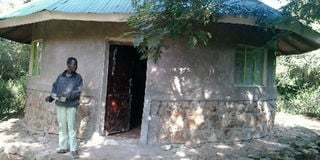Visit Ramogi Hill to learn more about Luo history

A cottage at Ramogi Hill in Bondo, which costs Sh5,000 a night. PHOTO | NATION MEDIA GROUP
What you need to know:
- The hill, popularly known as Got Ramogi by locals, is estimated to be seven kilometres from Usenge Town and 20 kilometres from Bondo.
- Prof Ogutu said Luos chose Ramogi Hill because of its unique nature. It provided protection to the Luos from attacks by their enemies.
For a sneak peek into Luo history and culture, the Ramogi Hill is definitely the place to visit.
The hill, popularly known as Got Ramogi by locals, is estimated to be seven kilometres from Usenge Town and 20 kilometres from Bondo.
It is a place where one will not only learn more about the history and culture of Luos, but also have adventure and fun.
The hilly and rough terrain, combined with the quiet ambiance below tall trees, makes it an ideal location for picnics, camping and corporate team building.
On reaching the top of Ramogi Hill, a visitor will have a good view of the vast Yala Swamp below, with its waters that eventually pour into Lake Victoria.
One can easily mistake the swamp for unploughed land because of the lovely greenery covering it.
Bird lovers will be fascinated by the resort. It is home to over 20 bird species as well as a variety of indigenous trees and flowers, some of which are endangered species.
University of Nairobi’s Prof Gilbert Ogutu, an expert in anthropology, said the name ‘Ramogi’ means the father of the Luo tribe. He said it is also a title given to a leader of the community.
The hill is of great significance to Luos because it is believed to be the first point where the community settled in Kenya from South Sudan, before dispersing to other parts of Nyanza and neighbouring countries such as Tanzania.
“The Ramogi Hill is a unifying factor for all the Luos in Siaya, Kisumu, Migori and Homa Bay counties, since their ancestors first settled there on their way from South Sudan through Uganda,” said Prof Ogutu.
DEEP HISTORY
Three kilometres from the foot of the hill are cottages, which come in handy for those who love camping.
A night in a cottage costs Sh5,000 including all the meals.
Mr Joseph Omolo, the caretaker of the cottages, assures campers of their security and calmness at night as they are surrounded by nature.
Beyond the cottages is a thick forest that is associated with a number of myths, for instance, that one can come into contact with Ramogi, the forefather of Luos.
When accessing the forest one has to pluck tree figs and put them into earthen pots surrounding the Rapogi Stone, located at the entry to the Ramogi Hill.
The Rapogi Stone is a huge pike of rock that Ramogi is said to have used as an altar.
Legend has it that Ramogi frequently prayed next to the stone to appease the gods to bless the area with rain in times of drought.
One has to be accompanied by a tour guide to ensure they do not disappear in the thick forest.
On climbing much higher, one will not fail to see the vague outline of a house. It is believed this was Ramogi’s home, known as Gunda.
Another interesting place to visit is the Kar-Dhiang. It is characterised by rocks that resemble the shapes of a cow and a calf. It is believed this is where Ramogi grazed his animals.
A big fig tree is located right in the middle of Ramogi Hill. The local residents believe the tree swallowed a number of axes and machetes of those who attempted to cut it down.




